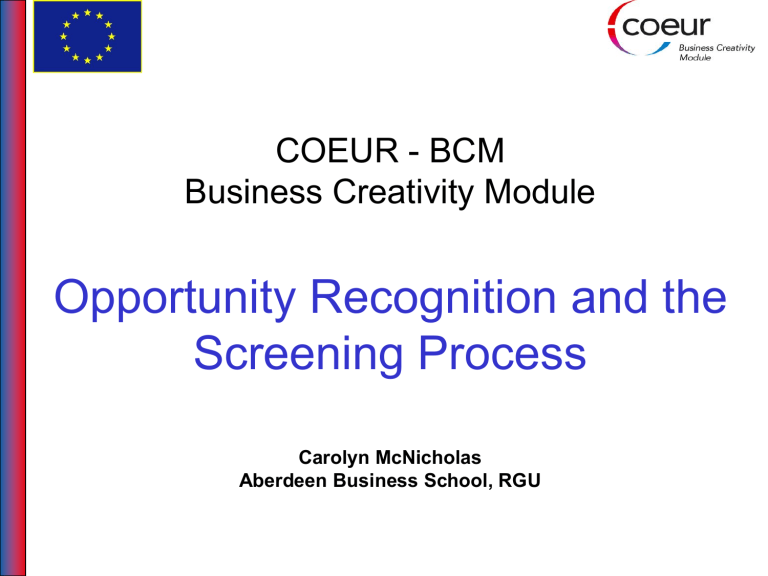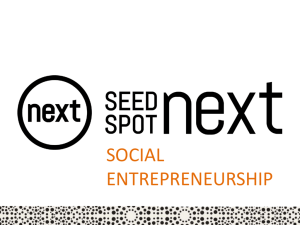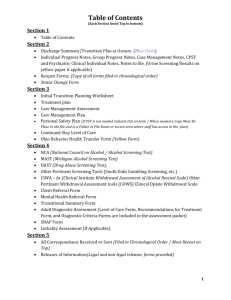PowerPoint-Präsentation

COEUR - BCM
Business Creativity Module
Opportunity Recognition and the
Screening Process
Carolyn McNicholas
Aberdeen Business School, RGU
Today’s Objectives
• Understand where business ideas come from
• Understand how to perform an initial high level screening / evaluation of business opportunities
• Understand the influence of the external environment
• Take away action – screening checklist
Business Creation & Start-up Process
Adapted from Deakins (2006)
Idea formulation
Opportunity Recognition
Pre-start Planning and
Preparation
Entry and Launch
Post-entry Development
where can you find
BIG
IDEAs
?
Sources of Ideas
• Every day problems / needs / complaints
– E.g. Sports Division / Cisco / Netflix
• Personal experience
– Work, home, education, skills and talents
• Hobbies and interests
– Lifestyle entrepreneurs
• Newspapers, magazines, media
• Other countries
• Deliberate Search
– Business Opportunity Profiles
– On-line databases
– Patents and licensing
• Factors of Change
Pizza Express Case Study
• Founded Peter Boizot – 1965
• Influenced by Italian and German experiences - pizzaiolos
• Formed an exclusive alliance with London’s only mozzarella maker
• By 2003 over 300 outlets in UK, Ireland,
Spain and France
External Environment Drives Change
•
P olitical/ L egal - legislation, taxation policy, employment law, health and safety, foreign trade, terrorism, war
• E conomic - local, national, global, industry – inflation, interest rates, employment rates, exchange rates, money supply, energy costs
•
S ocio-cultural
– population demographics, income distribution, lifestyle changes, education levels, social mobility, values, attitudes
•
T echnological - new products, new processes, new and emerging discoveries, internet, etc
•
E cological/Environmental
– Climate change, pollution, waste products, recycled technology, energy efficiency
USA – Some Hot Recent
Business Ideas
(www.entrepreneur.com)
• Consulting services
• Financial planning
• Personal Trainer
• Pet Products
• Mobile computer training
• Household cleaning
• Doula service
• Gardening
• Health services
• Tech Education
– For Kids
– For Seniors
• Maternity Clothes
• Online Learning
• Life Coach
• Security
• Senior Care Market
• Senior Clothes
• Art services
Drucker’s 7 Sources of Innovative
Opportunities
Organisational /
Sectoral
• The unexpected (event or success or failure)
• The incongruity – between what actually happens and plan
• The inadequacy in underlying processes
• The changes in industry or market structure
External
• Demographic changes
• Changes in perception, mood and meaning
• New knowledge (both scientific and non scientific)
Last is most difficult, least reliable and least predictable
The New Economy Favours Innovative
Companies / Entrepreneurs
The Economy :
• Globalisation
• Better world-wide communication
• The Internet and mobile communications
• Travel
• More economic interdependence
- EU, NAFTA etc.
• More volatility – terrorism, etc
Opportunity Recognition
• Converting an idea into a business opportunity is the key element of the process of business creation
• Entrepreneurs are attuned to opportunity
• Opportunity must take priority over innovation
• Opportunities are generated by change
Opportunity has Four
Essential Qualities -
Barringer and Ireland, 2006
• Attractive
• Durable
• Timely http://www.youtube.com/watch?v=ckLJVLhxzDA&feature=player_embedded
• Anchored in product/service which adds value to buyer/end user
“I never perfected an invention that I did not think about in terms of the service it might give others... I find out what the world needs, then I proceed to invent” Thomas Edison
Wow products /services such as the Dyson vacuum cleaner and the bar and massage service in Virgin Upper Class, Amazon
One Product is Not Enough!
• Dyson vacuum cleaner took 5 years and 5,127 prototypes
• First product, G-Force, sold for $2000 each in
Japan
• Vacuums, washing machines, Airblade hand dryer (sales $6 billion worldwide), Air
Multiplier
Window of Opportunity Varies
Internet Search Engines
• 1995 – Yahoo
• Quickly followed by Lycos, Excite,
AltaVista, etc
• 1998 – Google (advanced technology)
Ideas not Innovative
Opportunities
• Sinclair C5
• E-stamps and Stamps.com
• Tartan tanks
Evaluating Idea / Opportunity
• Must be a clearly defined market need
– Customer analysis, segments, motivations, unmet needs, gaps in market
• Idea needs to be economically viable
– Market attractiveness e.g. size? growth? trends? entry barriers?
– Profit potential?
– Resources needed / available?
• Technical feasibility
• Competitive advantage / USP
– Competitor analysis
• Fit with your personal / company objectives / experiences / core competencies
• Timing must be right – window of opportunity
• Risks / threats – Environmental analysis
What to look for
• Limitations of what’s currently available
• Trends and changes (beware fads)
• Something new and different
• Unfilled niche
• Technological advances
• Speed to market
Conclusions
• Generating ideas and new products is easy but you need customers and markets
• The real challenge is converting ideas into a business opportunity
• The better you understand your consumer the better your chances of winning in the market place
• Evaluation and assessment of markets is key to developing business ideas and new products and services
References
• Trott, P 2008 Innovation management and New Product Development
4th ed. Harlow:Prentice Hall
• Deakins, D and Freel, M. 2009. Entrepreneurship and Small Firms. 5th
Edition, McGraw Hill.
• Drucker, Peter F. Innovative and Entrepreneurship, Practice and
Principles. Harper & Row, Publishers, Inc. 1985
• Burns, P 2007 Entrepreneurship and Small Business 2 nd ed. Palgrave
• Barringer, B & Ireland, D 2006 Entrepreneurship: Successfully
Launching New Ventures 2nd ed. Prentice Hall
• Kotter, J.P 1997 The New Rules. Simon & Schuster .
• Franke, N, von Hippel, E & Schreier, M 2006 Finding commercially attractive user innovations: A test of lead user theory. Journal of
Product Innovation Management. V.23 pp301-315
• Venkataraman, S., and Shane, S., (2000) The Promise of
Entrepreneurship as A Field of Research, Academy of Management
Review , V. 25 (1) pp217-226.
• Cooper, R (1985) Selecting Winning new product projects; using the
NewProd system. Journal of Product Innovation Managment v2 0034-
44
• http://www.startups.co.uk/
• http://www.ifm.eng.cam.ac.uk/ctm/idm/cases/
COEUR - BCM
Business Creativity Module
Screening Checklist
Carolyn McNicholas
Aberdeen Business School, RGU
Screening Check List – Market Factors
Yes No
Is the market large?
Is the market highly competitive?
(Direct/indirect)
Is this an emerging / growth market?
Is there any pending legislation which might impact market demand?
Are there any obvious barriers to entry?
Are there reachable / receptive customers close by? (Think about distribution channels, etc)
Screening Check List – Competitive
Advantage?
Is there a well identified market need for the product/service?
Yes No
Can we establish a USP for our product / service? – Price?
Quality? Speed of response? Unique features?
Is our product / service a significant improvement on our competitors?
Can we protect our product?
Can we establish first mover advantage?
Screening Check List – Management
Capability
Yes
Do we have personal knowledge / experience / the right skills / experience?
Do we have an interest in the service?
Do we know other people who have the rights skills / experience?
Have we the right contacts and networks?
Is there specific training we can receive to improve our chances of success?
No
Screening Check List – Resources /
Economics
Yes No
Is this a low cost start up business model?
Do we have access to the money necessary to start this business?
Is this a sizeable / scaleable business opportunity?
Is it worth doing?
Screening Check List – Other
European dimension?
Personal / corporate values? e.g.
Environmental considerations
Cultural barriers and attitudes?
Yes No
Summary
• Need to tailor checklist to individual idea
• Seeking
– Large and growing market
– Reachable customers
– An innovative product which adds value
– Right window of opportunity
• Assess whether to abandon, reform or enhance the idea





